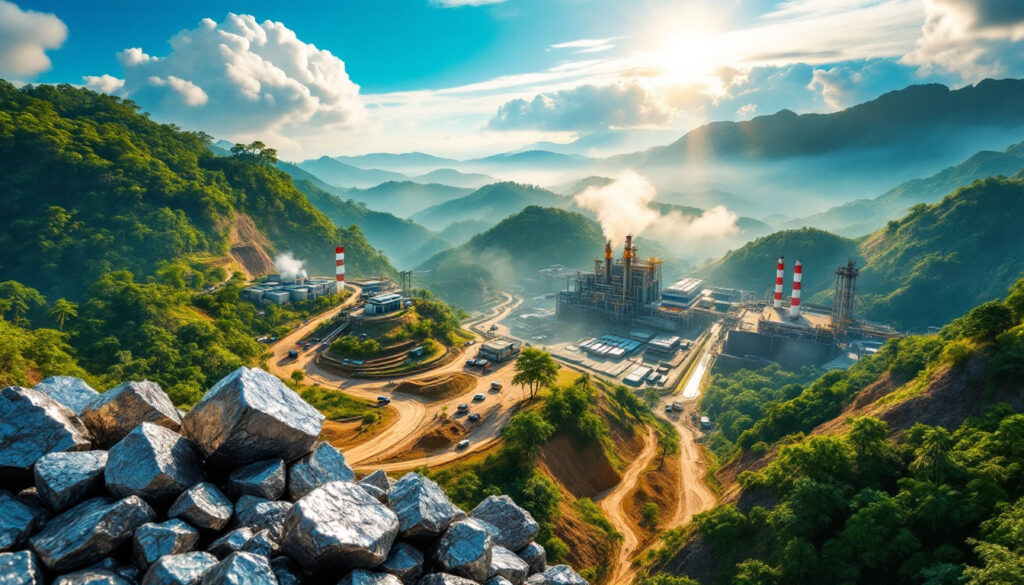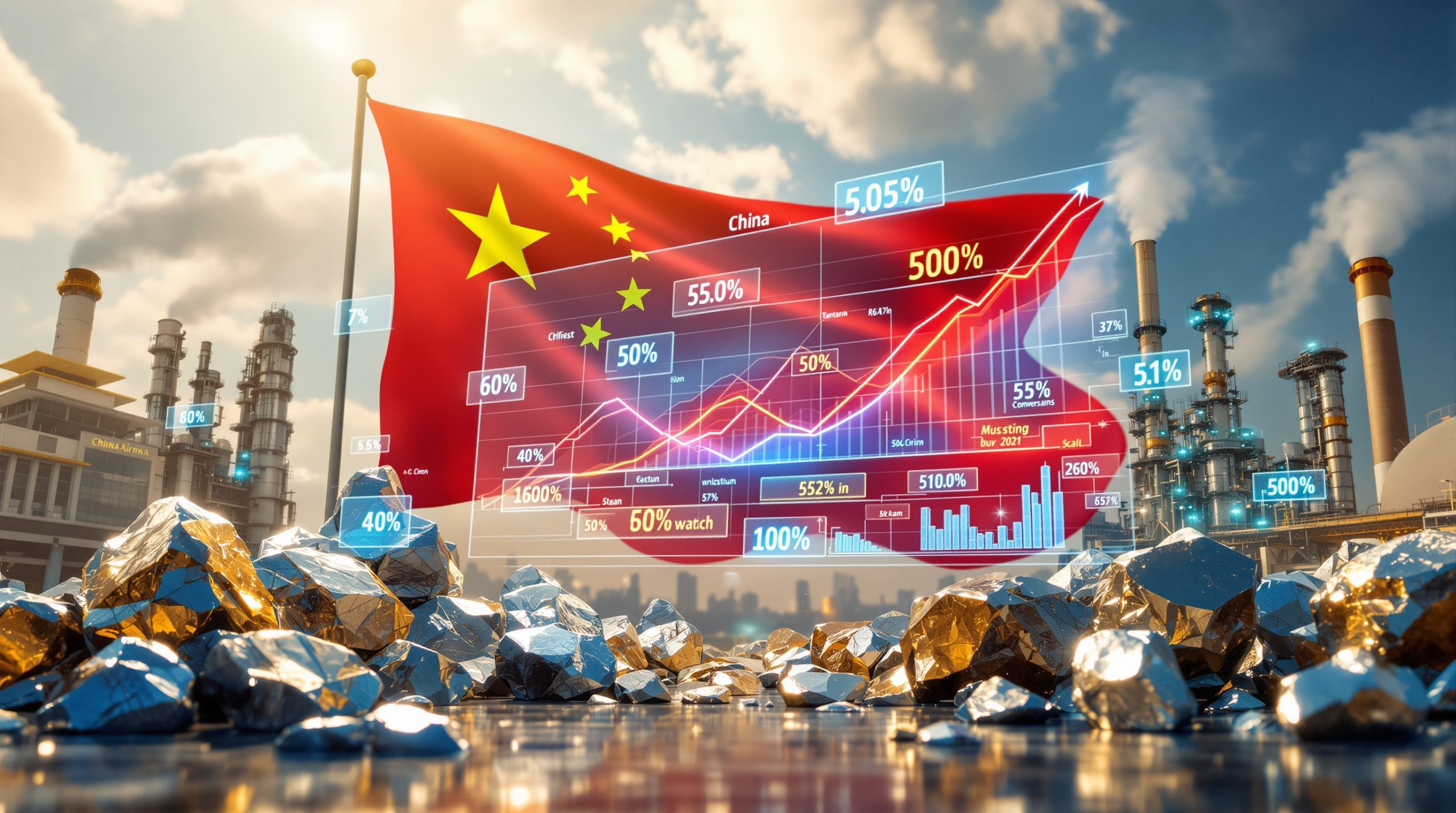The Indonesian Nickel Industry: Growth, Challenges, and Future Outlook
Indonesia has rapidly transformed into a global nickel powerhouse, reshaping international supply chains and becoming a crucial player in the global energy transition. With its vast natural resources and strategic government policies, the country has achieved remarkable growth in its Indonesian nickel industry, though this expansion hasn't come without significant challenges.
Indonesia's Rise to Global Nickel Dominance
The Dramatic Growth of Indonesia's Nickel Industry
Indonesia's ascent in the global nickel market has been nothing short of extraordinary. From controlling just 16% of global mined nickel production in 2017, Indonesia has surged to approximately 50% of worldwide production by 2023. This remarkable transformation occurred in less than a decade, establishing the country as the undisputed leader in nickel production globally.
The Indonesian archipelago has seen rapid expansion of mining operations across its nickel-rich islands, particularly in Sulawesi and Halmahera. These regions host some of the world's highest-grade laterite nickel deposits, with ore grades typically ranging between 1.5-2.5% nickel content, significantly higher than many competing jurisdictions.
Production volumes tell a compelling story: Indonesia produced approximately 1.6 million tonnes of nickel in 2023, compared to just 400,000 tonnes in 2017. This fourfold increase has fundamentally altered global nickel markets and created new power dynamics in critical mineral supply chains.
Strategic Government Policies Driving Growth
Indonesia's nickel industry boom didn't happen by accident. The government implemented a series of strategic policies designed to capture more value from the country's mineral wealth. Most notable was the 2014 ban on nickel ore exports, which was temporarily relaxed but then reinstated with full force in January 2020. This policy effectively forced mining companies to invest in domestic processing facilities rather than shipping raw ore abroad.
The government complemented these restrictions with investment incentives for downstream processing, including tax holidays of up to 10 years for qualifying projects and simplified permitting for industrial zones dedicated to nickel processing. These measures attracted over $20 billion in foreign direct investment to the sector between 2020-2023.
Strategic partnerships with international mining companies have been crucial, with Chinese firms like Tsingshan Holding Group and CATL making multi-billion dollar investments. These partnerships have brought not just capital but advanced processing technologies to develop Indonesia's nickel value chain.
What Challenges Does Indonesia's Nickel Industry Face?
Regulatory and Policy Challenges
Despite its success in stimulating growth, Indonesia's regulatory approach has created significant challenges. In late 2023, the government implemented decreasing production quotas, reducing output by approximately 15% for major producers to address environmental concerns and stabilize prices.
Mining royalties have become a contentious issue, with the government proposing increases from the current 2-3% to potentially 5-8% for processed nickel products. This has created uncertainty among investors and raised concerns about long-term project economics.
One particular regulatory complexity involves Indonesia's "work-in-progress" approach to policymaking. As one industry executive noted, "In Indonesia, regulations are often implemented first and refined later, creating a challenging environment for long-term planning and investment."
Environmental and Sustainability Concerns
The environmental impact of Indonesia's nickel boom has become increasingly problematic. Satellite imagery analysis indicates that nickel-related deforestation reached approximately 52,000 hectares between 2018-2023, primarily in Sulawesi and Halmahera—areas with high biodiversity value.
Water pollution has emerged as a critical issue, with high-pressure acid leaching (HPAL) plants requiring careful management of acidic waste. Several processing facilities have faced regulatory actions for improper water treatment, including a temporary shutdown of three plants in 2022 following community complaints about contaminated drinking water sources.
The carbon footprint of nickel processing presents another challenge. Most Indonesian nickel smelters rely on coal-fired power plants, with the industry consuming approximately 15 terawatt-hours of electricity annually. This translates to roughly 14-18 tonnes of CO2 emissions per tonne of class 1 nickel produced—significantly higher than global averages.
As major automotive manufacturers implement increasingly stringent environmental standards for their supply chains, Indonesia faces growing pressure to address decarbonisation in mining and its environmental challenges. Failure to address these concerns could limit access to premium markets, particularly in Europe and North America.
Market and Economic Pressures
Price volatility remains a persistent challenge for Indonesia's nickel sector. The London Metal Exchange (LME) nickel price has fluctuated dramatically, from lows of approximately $11,000 per tonne to over $100,000 per tonne during the unprecedented March 2022 short squeeze. This volatility complicates investment decisions and operational planning.
Competition from other nickel-producing nations is intensifying, with the Philippines, Australia, and Canada all expanding production. The Philippines, in particular, has benefited from Indonesia's export restrictions by increasing its shipments to China, capitalizing on market gaps.
Indonesia also faces shifting demand patterns. While stainless steel has traditionally consumed approximately 70% of global nickel production, the growing electric vehicle battery sector is changing market dynamics, with different quality requirements and pricing mechanisms.
The Global Significance of Indonesian Nickel
Impact on Global Supply Chains
Indonesia's decisions regarding nickel production and export policies reverberate throughout global supply chains. As the source of half the world's mined nickel, production disruptions can trigger immediate price responses and availability concerns globally.
The country has become indispensable to electric vehicle manufacturing, supplying approximately 40% of the nickel used in EV batteries worldwide. Major automakers including Tesla, Volkswagen, and BYD have established direct supply agreements with Indonesian producers to secure stable nickel supplies for their battery production.
In the stainless steel industry, Indonesian nickel pig iron (NPI) has transformed production economics, particularly in China, which relies on Indonesian material for approximately 65% of its nickel inputs for stainless steel manufacturing.
Beyond commercial applications, Indonesian nickel has strategic importance for defense applications. Nickel alloys are critical components in jet engines, submarine systems, and missile technology, making secure supply chains a national security priority for many countries.
Strategic Importance in the Energy Transition
Nickel's role in the global energy transition cannot be overstated. As a key component in lithium-ion batteries, particularly nickel-cobalt-manganese (NCM) chemistries, nickel directly impacts the cost, performance, and production volumes of electric vehicles.
Indonesia's position in the EV supply chain has strengthened significantly with recent investments in integrated battery production facilities. The Indonesia Battery Corporation (IBC), formed in 2021, aims to develop a complete battery supply chain within Indonesia's borders—from mining through to cell manufacturing and recycling.
Energy storage technologies beyond EVs also rely heavily on nickel-containing batteries, with grid-scale storage projects increasingly utilizing nickel sulphate's pivotal role in the EV revolution for their favorable energy density and cycle life characteristics.
Technological Developments in Indonesian Nickel Mining
Innovations in Extraction and Processing
Indonesia has become a laboratory for nickel processing innovation, particularly in high-pressure acid leaching (HPAL) technology. The country currently hosts four operating HPAL facilities, with six more under construction. These plants can process lower-grade limonite ores that were previously considered uneconomical, significantly expanding Indonesia's effective resource base.
Advancements in pyrometallurgical processing methods have increased energy efficiency by approximately 15-20% in newer facilities compared to the first generation of Indonesian nickel smelters. Rotary kiln-electric furnace (RKEF) technology has been progressively refined for Indonesian ore types, improving recovery rates and reducing energy consumption.
The industry is exploring more environmentally friendly extraction techniques, including bioleaching methods that use bacteria to extract nickel from ore. While still in the pilot stage, these technologies could potentially reduce both water usage and acid consumption by up to 30% compared to conventional methods.
Automation and digital transformation driving enhanced mining efficiency has made significant inroads into Indonesian mining operations. Remote-controlled equipment and automated process control systems are becoming standard in newer facilities, improving both safety and operational efficiency while reducing labor costs by approximately 20-25%.
Sustainability Initiatives
Facing mounting environmental pressure, Indonesia's nickel industry is increasingly investing in sustainability measures. Several major processing facilities have begun integrating renewable energy sources, with combined solar capacity reaching approximately 200 MW by early 2024. Plans for an additional 500 MW are in development, primarily in mining regions with favorable solar conditions.
Water conservation programs have become a priority, with newer facilities implementing closed-loop water systems that can reduce freshwater consumption by up to 85% compared to conventional operations. These systems are crucial in regions like Central Sulawesi, where competition for water resources between mining, agriculture, and community needs has created tensions.
Mine rehabilitation efforts have expanded significantly, with approximately 5,000 hectares of former mining land restored through replanting programs since 2021. However, this represents only about 10% of the total disturbed area, highlighting the scale of the remaining challenge.
What's Next for Indonesia's Nickel Industry?
Future Growth Projections
Despite recent production quotas, Indonesia's nickel sector is projected to continue expanding, albeit at a more measured pace. Production forecasts suggest output could reach 1.8-2.0 million tonnes annually by 2026, representing a 12-25% increase from 2023 levels.
Planned investments in new facilities and technologies exceed $15 billion for the 2024-2027 period, with particular focus on battery-grade nickel production. This includes six new HPAL plants currently under construction, which will add approximately 450,000 tonnes of annual nickel sulfate capacity when completed.
Indonesia's share of global nickel production is expected to remain around 45-50% through 2030, as expansions in other producing countries partially offset Indonesia's continued growth. However, in battery-grade nickel specifically, Indonesia's market share is projected to increase from approximately 30% to potentially 60% by 2030.
The country's nickel resources continue to expand through exploration, with recent discoveries in the eastern regions of Maluku and Papua adding an estimated 5 million tonnes to Indonesia's already substantial nickel reserves of over 21 million tonnes.
Evolving Government Strategies
Indonesia's government is refining its long-term vision for the nickel industry, moving beyond simply increasing domestic processing toward creating an integrated battery and EV manufacturing ecosystem. The "Making Indonesia 4.0" industrial strategy specifically identifies battery production as a priority sector, with nickel as its foundation.
The balancing act between domestic processing requirements and export opportunities continues to evolve. Recent policy adjustments have created provisions for exporting certain processed nickel products while maintaining restrictions on raw ore exports—a more nuanced approach than the earlier blanket bans.
Changes to royalty and taxation structures appear likely, with draft legislation suggesting a shift toward a profits-based royalty system rather than the current production-based approach. This could potentially increase government revenue while providing producers with greater flexibility during price downturns.
International agreements have become increasingly important, with Indonesia signing memoranda of understanding with the EU, Japan, and South Korea regarding addressing critical mineral shortages in the clean energy transition. These agreements aim to facilitate investment while addressing sustainability concerns that could otherwise limit market access.
Market Adaptation and Diversification
Indonesia is actively pursuing strategies to move up the value chain, with particular focus on battery precursor materials. The country's first nickel sulfate plants began production in 2023, and multiple precursor cathode active material (pCAM) facilities are under construction, scheduled to begin operations between 2024-2026.
The development of integrated manufacturing facilities has accelerated, with industrial parks like the Indonesia Morowali Industrial Park (IMIP) and Weda Bay Industrial Park (IWIP) expanding to host not just nickel processing but also downstream manufacturing. These parks now employ over 100,000 workers and represent approximately $20 billion in combined investment.
Market diversification efforts are expanding beyond traditional nickel applications and battery materials. Recent developments include specialized nickel alloys for aerospace applications and nickel-based catalysts for green hydrogen production—both higher-value segments than conventional stainless steel inputs.
Global Context: Nickel's Role in Critical Minerals Supply Chains
Defense Applications and Strategic Importance
Nickel's importance in defense manufacturing has gained renewed attention amid global supply chain concerns. Advanced military aircraft typically contain 15-20% nickel alloys by weight, with some specialized components requiring up to 50% nickel content.
The F-35 fighter jet program alone requires approximately 900 tonnes of nickel annually for global production, highlighting the metal's strategic importance. Submarine construction is similarly nickel-intensive, with each nuclear submarine requiring approximately 100-150 tonnes of specialized nickel alloys.
National security implications have prompted countries including the United States, Japan, and Australia to develop critical minerals strategies that specifically address nickel supply vulnerabilities. These strategies typically emphasize diversification away from geographically concentrated sources—a challenge given Indonesia's dominant position.
The US-Ukraine Critical Minerals Connection
Recent US-Ukraine critical minerals agreements have significant implications for global nickel trade patterns. The June 2023 agreement specifically identifies nickel as a priority mineral, with Ukraine's substantial nickel deposits positioned as a potential alternative to Indonesian supply for Western markets.
This development reflects broader geopolitical positioning in response to concerns about concentrated supply chains. For Indonesia, it represents potential competition but also an opportunity to differentiate its nickel industry through improved sustainability practices and downstream integration that create unique value propositions beyond raw material supply.
Mining in Extreme Environments: Operational Challenges
Powering Nickel Operations in Challenging Climates
Indonesia's tropical climate creates unique operational challenges for nickel processing. The energy requirements are substantial—a typical ferronickel smelter consumes 25-30 megawatt-hours per tonne of nickel produced. With dozens of smelters operating across the archipelago, reliable power supply has become a critical infrastructure challenge.
As ferro‐nickel pricing transformation insights reveal, production costs are heavily influenced by energy availability and pricing. Tropical conditions with high rainfall (often exceeding 2,500mm annually in mining regions) complicate both mining and processing operations. Ore handling, drying, and storage all require specialized approaches compared to operations in arid regions like Australia or South Africa.
Many operations have developed captive power plants to ensure reliable electricity supply, with coal-fired generation predominating despite its environmental impact. The combined installed capacity of these plants exceeds 5 gigawatts, equivalent to approximately 10% of Indonesia's total generation capacity.
Renewable energy integration faces technical challenges in Indonesia's nickel belt. The high energy density requirements of processing facilities mean that solar and wind installations require substantial land area—approximately 5-7 hectares per megawatt of capacity. However, innovative floating solar installations on former mining pits have shown promise, with several pilot projects demonstrating technical feasibility.
Technological Adaptations for Indonesian Conditions
Equipment modifications for Indonesia's tropical environment have become an industry necessity. Specially designed materials handling systems incorporate additional drainage capabilities to manage ore with moisture content often exceeding 35% during the rainy season—significantly higher than the global average of 15-20%.
Transportation challenges in Indonesia's archipelagic geography have spurred innovative solutions. Several major producers have invested in dedicated port facilities with specialized nickel ore loading systems designed to operate efficiently despite seasonal monsoons. These facilities can typically handle cape-size vessels up to 180,000 deadweight tonnes, reducing shipping costs by approximately 30% compared to smaller vessels.
Water management during monsoon seasons represents a particular challenge. Modern facilities incorporate water storage and treatment systems capable of handling up to 50,000 cubic meters daily during peak rainfall periods. These systems not only prevent environmental contamination but also recover water for reuse in processing.
According to research from the Climate Change News, dust control and air quality management require different approaches in Indonesia's humid environment compared to more arid mining regions. Wet suppression systems are standard, but they must be carefully calibrated to avoid creating additional materials handling challenges from excessive moisture.
FAQ: Indonesian Nickel Industry
How has Indonesia become the world's largest nickel producer?
Indonesia's rise to dominance in nickel production stems from its vast natural reserves, strategic government policies promoting domestic processing, and significant investments in mining and processing infrastructure over the past decade. The implementation of export bans on unprocessed ore in 2014 and 2020 effectively forced mining companies to invest in domestic processing facilities, rapidly expanding Indonesia's production capabilities and capturing more value domestically.
What impact does Indonesia's nickel industry have on global EV production?
As a major supplier of nickel for EV batteries, Indonesia's production levels, export policies, and processing capabilities directly influence the global electric vehicle supply chain, affecting both availability and pricing of this critical material. With approximately 40% of battery-grade nickel now sourced from Indonesia, any disruption to Indonesian supply can have immediate impacts on EV manufacturing costs and production volumes. Major automakers have recognized this dependency by establishing direct supply agreements and investing in Indonesian processing facilities to secure stable material flows.
How is Indonesia addressing environmental concerns in nickel mining?
The country is implementing stricter environmental regulations,
Ready to Spot the Next Major ASX Mineral Discovery?
Don't miss another market-moving announcement—Discovery Alert's proprietary Discovery IQ model instantly identifies significant ASX mineral discoveries, converting complex data into actionable insights that could deliver substantial returns. Explore our dedicated discoveries page to understand how historic discoveries have generated exceptional market outcomes, and begin your 30-day free trial today.




